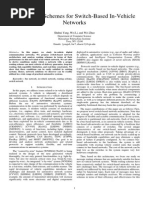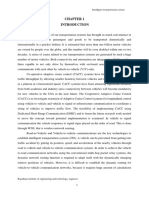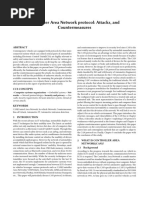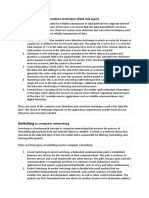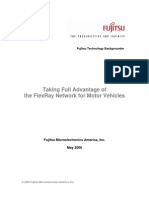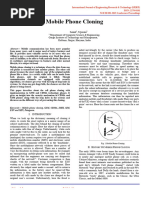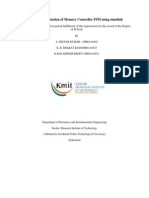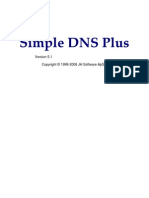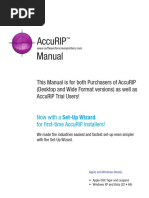10 5923 J Ajsp 20110102 07
10 5923 J Ajsp 20110102 07
Uploaded by
markuleCopyright:
Available Formats
10 5923 J Ajsp 20110102 07
10 5923 J Ajsp 20110102 07
Uploaded by
markuleOriginal Title
Copyright
Available Formats
Share this document
Did you find this document useful?
Is this content inappropriate?
Copyright:
Available Formats
10 5923 J Ajsp 20110102 07
10 5923 J Ajsp 20110102 07
Uploaded by
markuleCopyright:
Available Formats
American Journal of Signal Processing. 2011; 1(2): 40-45 DOI: 10.5923/j.ajsp.20110102.
07
Design of an In-Vehicle Network (Using LIN, CAN and FlexRay), Gateway and its Diagnostics Using Vector CANoe
Rishvanth1, D. Valli2, K. Ganesan2,*
1 2
B.Tech in Electronics and Communication Engineering, VIT University, Vellore TIFAC-CORE in Automotive Infotronics, VIT University, Vellore, 632014, India
Abstract Todays vehicles include a complex symbiosis of intelligent electronic systems and integrated mechanical structures. In-vehicle networks provide an efficient method of communication between the various electronic components in an automobile. The communication protocols discussed in this paper are Local Interconnect Network (LIN), Controller Area Network (CAN) and FlexRay. LIN is used in low speed applications, CAN are used in medium speed applications and FlexRay is used in high speed applications. A gateway is a network node used to transfer data from one communication protocol to another. Vector CANoe is an all-round tool for the development, testing and analysis of entire ECU networks and individual ECUs. Vector CANoe uses a 3-phase development process that assists the user from the planning of the distributed system to the implementation of it. In this paper we have explained how to create 3 different networks (LIN, CAN and FlexRay) and also designed a gateway so that the messages can be transferred between different communication protocols. To start with we tested the design of the gateway using simulations and subsequently we have connected the necessary hardware and diagnosed the messages. Keywords LIN, CAN, FlexRay, Gateway, Diagnostics
virtual and the physical bus for the simulation of the remainder of the bus. After the development CANoe can be used to analyze the physical network for bus statistics. The in-vehicle networking concepts are nowadays used in safety systems such as collision avoidance systems[3]. Hybrid Network, provides not only the communication functions of different in-vehicle subsystems, but also the controlling policy, authentication and human-computer interactions, and can improve the safety and comfort of driving[4]. The various control modules of a vehicle such as Engine Control Modules, Transmission Control Modules and Body Control Modules etc. usually communicate with each other, in real time, helping in the operation of the vehicle[5,6]. The past few years have seen a large growth in the number and type of communication buses used in automobiles, trucks, construction equipment, and military, among others[7]. Recently FPGA based networking are used for high data rate and reliable in-vehicle communication[8]. The simulation environment is the initial step to design cost effective, flexible and deterministic in-vehicle networks suitable for use in the next generation of vehicles[9]. People started using switch-based network architecture and analyze the various routing schemes in terms of their performance in in-vehicle networks[10]. The paper is organized as follows: In section 2, we introduce the various protocols such as LIN, CAN and FlexRay in sections 2.1, 2.2 and 2.3 respectively. Subse-
1. Introduction
In an automobile the number of electronic components is increasing exponentially. In the automobiles manufactured today number of electronic sensors and actuators are very high so that point-to-point communication is not possible. The main reasons being the large number of wires needed to connect all the components, non-availability of space and in case of a failure the fault detection will be extremely difficult. All these factors lead to the development of a distributed system in which all the components are connected to various bus and the devices communicate with each other using standardized automotive protocols. LIN, CAN and FlexRay are some of the protocols used in automobiles today for communicating between the various components. A gateway is designed to transfer messages between different communication protocols[1,2]. Vector CANoe is a tool that assists in the development of the In-vehicle Network using various protocols. This tool allows the user to simulate the various networks and the gateway before the actual development process. During the development process the tool can be used to integrate the
* Corresponding author: kganesan@vit.ac.in (K. Ganesan) Published online at http://journal.sapub.org/ajsp Copyright 2011 Scientific & Academic Publishing. All Rights Reserved
41
American Journal of Signal Processing. 2011; 1(2): 40-45
quently in section 2.4 we introduce the Vector CANoe tool which is used for the development of the present system. In section 3, we talk about the three phase development model used for the present work. The various steps involved in the design of network using Vector CANoe are explained in detail in section 4. In the final section 5, we derive our conclusions.
2. Concept of LIN, CAN and FlexRay
2.1. LIN LIN is a low speed asynchronous bus offering a data rate of upto 20kbps; it is used in the non-critical applications. It is a low cost and single wire communication network and it is implemented using the UART/SCI interface in microcontrollers[11,12]. A LIN network uses master-slave architecture as shown in Fig.1 below.
higher priority information is gaining the bus access[14]. A CAN data frame is used for transmitting data and it can transmit a maximum payload of 8 bytes. This frame includes the message address, Data Code Length (DLC), checksum and the acknowledgement field. If a standard identifier is used, the message identifier consists of 11 bits (as shown in Fig.3 below) and if extended identifier is used it consists of 29 bits. All CAN messages are broadcast to every node, thus node-specific filtering is required to receive the required messages.
Figure 3. CAN Frame Format
2.3. FlexRay FlexRay is a serial communication technology offering a data rate of up to 20Mbps designed for safety-critical areas and in x-by-wire applications in an automobile. FlexRay uses two channels for communication, namely Channel A and Channel B, each consisting of a pair of wires. FlexRay communication is not restricted to any specific topology. To minimize the risk of failure, FlexRay provides for the redundant layout of the communication channels, time determinism of message transmission and error tolerance. Each of the channels may be operated simultaneously at 10 Mbps or the redundant channel may be used to increase the data rate to 20 Mbps. FlexRay network supports bus, star and hybrid network topologies[15,16].
Figure 1. Master-Slave Architecture
The LIN master sends a frame header and the LIN slave responds to it by sending a frame. It consists of one master node and several slave nodes. The master node performs the master task in addition to the slave task. The LIN frame consists of a frame header and response as shown in Fig. 2 below. The header contains the response identifier. One slave node responds to the identifier and it transmits the frame response and several slave nodes respond to the identifier and receive the frame response. The response consists of a data field and a checksum field.
Figure 2. LIN Frame
2.2. CAN CAN is a medium speed asynchronous bus offering a data rate of up to 1Mbps, it is used mainly in the sensor based applications. It uses an unshielded twisted two-wire line as the physical transmission medium and it is implemented using CAN controller interface in a microcontroller. CAN network is based on a combination of multi-master architecture and line topology. Any CAN node can place a message on the CAN bus[13]. The transmission of a CAN message does not follow any predetermined time sequence rather it is event-driven. The bus access is initiated when the bus is idle, by bus arbitration process, by which it is ensured that
Figure 4. Principle of bus access
A FlexRay communication cycle consists of Static slots and Dynamic slots as shown in Fig.4 above. Static slots use the TDMA method (Time Division Multiple Access) and Dynamic slots use FTDMA method (Flexible Time Division Multiple Access) for bus access. Static slot consists of equal lengths and during the communication cycle each FlexRay node is guaranteed access to the communication bus according to the schedule. Then the communication cycle consists of dynamic slots for messages in a FlexRay cluster that should not be transmitted on a fixed time schedule but on
Rishvanth et al.: Design of an In-Vehicle Network (using LIN, CAN and FlexRay), Gateway and its Diagnostics Using Vector CANoe
42
an event driven basis. Being Time division multiple access based communication scheme, FlexRay network startup is performed on all nodes synchronously. A node called Coldstart node initiates startup process. Maximum three nodes are configured as Coldstart nodes and at least two fault-free nodes are needed for startup process. The leading Coldstart node send collision avoidance symbol to begin the startup process, it is then joined by other Coldstart nodes and afterwards by all other nodes. The Clock synchronization is achieved by calculation of offset and rate correction value to compensate frequency and phase differences that occur among Electronic Control Units[16]. A FlexRay frame consists of a header, payload and a trailer. The header consists of 40 bits and it contains the indicators, identifiers, Payload length, Header CRC and cyclic count. The payload can consist of 0-254 bytes and the payload length shows the length of the payload. The payload consists of the static and the dynamic segment. To protect the payload CRC method is used. The CRC is calculated with the header, payload and the CRC polynomial defined in the specification. The CRC sequence is appended to the payload as a trailer as shown in Fig.5 below.
functionality of the system among different network nodes and refines the design to the level of the network node as shown in Fig.6 below. This includes defining messages and selecting the baud rate of the bus. Finally the bus behaviour of individual network nodes must be specified, e.g. in the form of cycle times or more complex protocols. Then this information can be evaluated first by the simulation tool to provide initial estimates of bus load and the latency times to be expected at the prescribed baud rate. Afterwards, this specification can also be utilized for testing in subsequent phases.
Figure 6. Phase 1
For a more accurate study, a dynamic functional model of the overall system is created. This involves specifying the behaviour of the network nodes with regard to input and output variables and the messages to be received and transmitted. Especially useful here is an event-driven model with a procedural description of behaviour. For example, the model may describe how - after receiving a message (Event) - the received data are to be further processed (procedural) and how the result is to be output as a control variable. The user must also specify the input variables to the simulation tool, so that the time behaviour of network nodes and the accumulation of messages can be simulated. The results of the simulation serve to validate the design and can later be used as a reference after implementation.
Figure 5. FlexRay Frame Format
2.4. Vector CANoe CANoe is a universal development, test and analysis environment for serial bus systems, which is made available to all project participants over the entire development process. The system is supported in functional distribution, functional checking and integration of the overall system. It is used to obtain an ideal test environment by simulation of the remainder of the bus and environment[17].
Figure 7. Phase 2
3. Three Phase Development Model
The development process using Vector CANoe is based on a multiple phase model which differentiates between three development stages: 3.1. Phase 1: Requirement Analysis and Design of the Network System First, the user responsible for design distributes the overall
3.2. Phase 2: Implementation of Components with Simulation of Remainder of the Bus After the first phase has been completed the design and development of individual network nodes is usually performed by all participants, independently and in parallel as shown in Fig.7 below. The models for the other network nodes can now be used to simulate the remainder of the bus for testing of a developed network node. The tool requires an
43
American Journal of Signal Processing. 2011; 1(2): 40-45
interface to the real bus. For this, it must be able to conduct the simulation in real time. 3.3. Phase 3: Integration of the Overall System In this last development phase all real network nodes are connected to the bus in a step-by-step manner as shown in Fig.8 below. To accomplish this it must be possible to "disconnect" the models one-by-one in the simulation of the remainder of the bus. The tool serves increasingly as an intelligent analysis tool which observes the message traffic between the real network nodes on the bus and compares the results with the specified requirements.
Figure 10. Vector LIN File Editor
Figure 8. Phase 3
4. Steps to Design a Network using Vector CANoe
The following were used in creating and analyzing a network using Vector CANoe: Step 1: We need to create a database that describes the entire network.
Figure 11. FIBEX Explorer
Step 2: We can create necessary panels to describe the nodes peripherals now. Panels in Vector CANoe are created using the software Panel Editor. This is shown in Fig.12 below.
Figure 12. Panels in Vector CANoe
Figure 9. Vector CANdb++ Editor
The database is created using the software Vector CANdb ++ Editor for a CAN network. This software creates a .dbc file as shown in Fig. 9 below. For a LIN network the database is created using the software Vector LIN File Editor. This software creates a LIN Description File (LDF) as shown below in Fig.10 and for a FlexRay Network the database is created using FIBEX Explorer software. This software creates a FIBEX file (.xml) as shown in Fig. 11 below.
Step 3: Now one has to create network nodes. Network nodes are created in the simulation window of Vector CANoe. This is a separate simulation window for each of the network i.e. a separate window for CAN, LIN and FlexRay network. Figs.13 and 14 below show the creation of CAN and FlexRay networks. Step 4: One writes the CAPL programs for each node. The universal applicability of CANoe results in large measure from its user programmability. The Communication Access Programming Language CAPL is a C like programming language, which allows us to program CANoe for
Rishvanth et al.: Design of an In-Vehicle Network (using LIN, CAN and FlexRay), Gateway and its Diagnostics Using Vector CANoe
44
individual applications. Thus the data traffic of all remaining stations can be simulated with the help of CAPL. We can also write programs for problem-specific analysis of data traffic with CAPL, or we can program a gateway a connecting element between two buses to exchange data between different CAN buses.
Step 5: Finally one can simulate and analyze the results. After the hardware implementation of the networks, the busses are connected to Vector CANoe to view the messages being transferred on the bus and it analyzes the bus for error frames, bus load, etc. For connecting the CAN bus to Vector CANoe a hardware called the CANcaseXL is used. This hardware does not need any power supply and the channel 1 of it connects to the CAN bus as shown in Fig.16 below.
Figure 13. Network Nodes for CAN Network Figure 16. Vector CANcase XL
Figure 14. Network nodes for FlexRay network Figure 17. Vector VN3400 FlexRay Inter
Figure 15. CAPL Browser
CAPL nodes are inserted in the data flow plan as function blocks. Event procedures serve as inputs in CAPL. These procedures can react to external events (e.g. the occurrence of specific messages). We can send messages by calling the function output(). These language tools and symbolic access to the various variables in the database make it possible to create simple prototypical models of nodes. The event procedures can be edited in the user-friendly browser as shown in Fig.15 below.
Figure 18. Vector Diagnostics Window
For connecting the FlexRay bus to Vector CANoe a hardware called the Vector VN3400 FlexRay Interface is used. It needs an external power supply and both the channels of the FlexRay bus can be connected using the same hardware as shown in Fig.17. The Figure 18 above shows the diagnostics window of Vector CANoe. All the messages being transferred on the network busses can be seen on the Trace window. The statistics window
45
American Journal of Signal Processing. 2011; 1(2): 40-45
shows the graph of the messages being transferred per second. The Bus Statistics window shows the current bus load, peak load, number of standard, data and error frame. The write window displays any diagnostic messages.
[5]
B.K.Ramesh, K. Srirama Murthy, In-vehicle networking, Dearborn electronics. http://www.deindia.com/images/downloads/whitepapers/InVehicle_Networking.pdf Christopher A. Lupini, In-Vehicle Networking Technology for 2010 and Beyond, Delphi Corporation, SAE International, 2010-01-0687, 2010 Junshan Gao, Yixiang Zhang, Bo Wu, The design of a vehicle network CAN/LIN gateway based on ARM IEEE International Conference on E-Product E-Service and E-Entertainment (ICEEE), November 2010 Sergio Saponara, Esa Petri, Marco Tonarelli, Iacopo Del Corona, Luca Fanucci, FPGA-based Networking Systems for High Data-rate and Reliable In-vehicle Communications, Design, Automation & Test in Europe Conference & Exhibition, DATE '07, pp.1-6, 2007 Shane Tuohy, Martin Glavin,Ciarn Hughes, Edward Jones, Liam Kilmartin, An ns3 based Simulation Testbed for In-Vehicle Communication Networks, www.eee.nuigalway.ie/Research/car/documents/stuohy_ukp ew2011.pdf
5. Conclusions
This paper explains the concepts of the various protocols used in In-Vehicle networks and with the help of the analysis tool Vector CANoe all the protocols are tested and diagnosed using the three phase development process. The gateway is also designed using this software. Finally, all the networks were tested and the required modifications were made using CANoe until the requirements were met.
[6]
[7]
[8]
ACKNOWLEDGEMENTS
This work forms part of the Research and Development activities of TIFAC-CORE in Automotive Infotronics located at VIT University, Vellore 632 014. The authors would like to thank the TIFAC-CORE for providing the necessary facilities (both hardware and software) to carry out this work successfully.
[9]
[10] Shuhui Yang, Wei Li, and Wei Zhao, On Routing Schemes for Switch-Based In-Vehicle Networks, IEEE Conference on Computer Communications Workshops (INFOCOM WKSHPS), pp.678-683, 2011 [11] K. Y. Cho, C. H. Bae, Y. Chu and M. W. Suh, Overview of Telematics : A system architecture approach, International Journal of Automotive Technology, Vol. 7, No. 4, pp. 509517 (2006) [12] LIN protocol specification, Version 2.1, 2006. http://www.lin-subbus.org [13] Karl Henrik Johansson, Martin Torngren, Lars Nielsen, Vehicle Applications of Controller Area Network, Handbook of Networked and Embedded Control Systems, Springer Verlag, Boston, 2005 [14] Bosch. CAN Specification, Version 2.0, 1991. http://esd.cs.ucr.edu/webres/can20.pdf [15] H. Li, H. Zhang, D. Peng, and W. Huang, "Design and application of communication gateway based on FlexRay and CAN," in International Conference on Electronic Computer Technology, pp. 664-668, 2009 [16] FlexRay communication system, protocol specification, version 2.0, http://www.flexray.com/ [17] www.Vector.com
REFERENCES
[1] Li, G-X, Qin, G-H, Liu, W-J, Zhang, J-D, Design and Implementation of Vehicle Gateway Based on CAN Bus Journal of Jilin University. Information Science Edition. Vol. 28, no. 2, pp. 166-171. Mar 2010 Schmidt, E.G.; Alkan, M.; Schmidt, K.; Yuru klu, E.; Karakaya, U, Performance evaluation of FlexRay/CAN networks interconnected by a gateway IEEE Industrial Embedded Systems (SIES), 2010 International Symposium, PP 209 - 212 July 2010 William D. Horne, Edward P. Olechna, and Ronald Brunot, Application of In-vehicle data buses for collision avoidance systems, IEEE Conference on Intelligent Transportation System, ITSC97, pp.433-438, 1997 Zhaohui Wu, Qing Wu, Jie Sun, Zhigang Gao, Bin Wu and Mingde Zhao, ScudWare: A Context-Aware and Lightweight Middleware for Smart Vehicle Space, Lecture Notes in Computer Science, Volume 3605/2005, 266-273, 2005
[2]
[3]
[4]
You might also like
- Control Logix With Delta VDocument21 pagesControl Logix With Delta VDaniel Pereira CarvalhoNo ratings yet
- Ami BiosDocument4 pagesAmi BiosMaru Olales100% (1)
- Design of An In-Vehicle Network (Using Lin, Can and Flexray), Gateway and Its Diagnostics Using Vector CanoeDocument6 pagesDesign of An In-Vehicle Network (Using Lin, Can and Flexray), Gateway and Its Diagnostics Using Vector Canoesarah bejaouiNo ratings yet
- Design of A FlexRay-Ethernet Gateway and Security Mechanism For In-Vehicle NetworksDocument15 pagesDesign of A FlexRay-Ethernet Gateway and Security Mechanism For In-Vehicle NetworksErdinç AVCINo ratings yet
- CAN Protocol PDFDocument12 pagesCAN Protocol PDFGiritharan RNo ratings yet
- On Routing Schemes For Switch-Based In-Vehicle Networks: Shuhui Yang, Wei Li, and Wei ZhaoDocument15 pagesOn Routing Schemes For Switch-Based In-Vehicle Networks: Shuhui Yang, Wei Li, and Wei ZhaoAlex ParampampamNo ratings yet
- Vehicle Applications of Controller Area NetworkDocument25 pagesVehicle Applications of Controller Area NetworkCastilhoMecNo ratings yet
- International Refereed Journal of Engineering and Science (IRJES)Document6 pagesInternational Refereed Journal of Engineering and Science (IRJES)www.irjes.comNo ratings yet
- Controller Area NetworkDocument51 pagesController Area Networkmaster vijayNo ratings yet
- Implementation of Inter and Intra Vehicular Communication SystemDocument7 pagesImplementation of Inter and Intra Vehicular Communication SystemInternational Journal of Application or Innovation in Engineering & ManagementNo ratings yet
- 6 Module 15 PagesDocument15 pages6 Module 15 PagesJarin TNo ratings yet
- Real-Time Error Measurement System For MVB ProtocolDocument7 pagesReal-Time Error Measurement System For MVB Protocolerode els erodeNo ratings yet
- An FPGA Implementation of CAN Protocol in AutomobilesDocument7 pagesAn FPGA Implementation of CAN Protocol in AutomobilesShreyas S RNo ratings yet
- Infrastructure To Vehicle Real Time Secured Communication: Ms - Smita Narendra Pathak, Prof - Urmila ShrawankarDocument5 pagesInfrastructure To Vehicle Real Time Secured Communication: Ms - Smita Narendra Pathak, Prof - Urmila ShrawankarChennamsetyNo ratings yet
- Efficient Authentication and Privacy Mechanism To Protect Legitimate Vehicles in IEEE 802.11p StandardDocument6 pagesEfficient Authentication and Privacy Mechanism To Protect Legitimate Vehicles in IEEE 802.11p Standardhadi kusumaNo ratings yet
- Intelligent Transportation SystemDocument13 pagesIntelligent Transportation SystemZION LIFENo ratings yet
- Time-Sensitive Networking in Automotive Embedded Systems - State of The Art and Research OpportunitiesDocument15 pagesTime-Sensitive Networking in Automotive Embedded Systems - State of The Art and Research Opportunitiessmyethdrath24No ratings yet
- Juenal CorbaDocument12 pagesJuenal CorbaLaura Veronika Diah MousehunterNo ratings yet
- Ijett V4i10p127 PDFDocument6 pagesIjett V4i10p127 PDFAshok Siva Kumar PoojalaNo ratings yet
- Computer Network Long Questions & AnswerDocument12 pagesComputer Network Long Questions & Answersravan123No ratings yet
- Automotive Networks Are ViewDocument7 pagesAutomotive Networks Are Viewazeez shaikNo ratings yet
- Vehicle-to-Vehicle Safety Messaging in DSRCDocument10 pagesVehicle-to-Vehicle Safety Messaging in DSRCAnupam SamantaNo ratings yet
- 5 Simulation Based Performance of Mumbai-Pune Expressway Scenario For Vehicle-To-Vehicle Communication Using2013.Vaishalid - KhairnarDocument17 pages5 Simulation Based Performance of Mumbai-Pune Expressway Scenario For Vehicle-To-Vehicle Communication Using2013.Vaishalid - Khairnaraepatil74No ratings yet
- Controller Area Network Protocol: Attacks, and CountermeasuresDocument11 pagesController Area Network Protocol: Attacks, and CountermeasuresThe HijackerNo ratings yet
- Missing AnswersDocument8 pagesMissing AnswersManzil TanvirNo ratings yet
- Prologue: 1.1 PreambleDocument10 pagesPrologue: 1.1 PreambleAshok KrishnaNo ratings yet
- Performance Evaluation of Control Networks: Ethernet, Controlnet, and DevicenetDocument33 pagesPerformance Evaluation of Control Networks: Ethernet, Controlnet, and DevicenetSudheerNo ratings yet
- Networking NotesDocument10 pagesNetworking NotesADITYA RAJNo ratings yet
- Session 1 Notes - Automotive NetworkingDocument48 pagesSession 1 Notes - Automotive NetworkingShruthiNo ratings yet
- c821 PDFDocument12 pagesc821 PDFramya vattamwarNo ratings yet
- SMS Based Home Automation Using CAN ProtocolDocument6 pagesSMS Based Home Automation Using CAN ProtocolEditor IJRITCC100% (1)
- Jatau Isaac Katuka, Yahaya Shagaiya Daniel, Bako Sunday SamuelDocument8 pagesJatau Isaac Katuka, Yahaya Shagaiya Daniel, Bako Sunday SamuelIJMERNo ratings yet
- VinayKumarV MRaghavaCharyulu 129Document7 pagesVinayKumarV MRaghavaCharyulu 129YevhenNo ratings yet
- Viva VoceDocument5 pagesViva VocesathishNo ratings yet
- The Car Is Like A Human Body:: The CAN Bus History in ShortDocument8 pagesThe Car Is Like A Human Body:: The CAN Bus History in Shortpunit_scribd71No ratings yet
- AI Exp 7Document7 pagesAI Exp 7akash kurheNo ratings yet
- Frame Relay NotesDocument3 pagesFrame Relay NotesRajender Kumar GolaNo ratings yet
- Network Technologies LLL UnitDocument20 pagesNetwork Technologies LLL Unitjefferjam716No ratings yet
- Network 15 SamerDocument10 pagesNetwork 15 SamerRedha Al-Rube'eNo ratings yet
- An Overview of Controller Area Network (CAN) Technology: November 12, 2003Document20 pagesAn Overview of Controller Area Network (CAN) Technology: November 12, 2003Dilyan MarinoffNo ratings yet
- Opnet ResearchDocument7 pagesOpnet Researchhossam80No ratings yet
- Introduction To In-Vehicle NetworkingDocument21 pagesIntroduction To In-Vehicle NetworkingryandaprakosoNo ratings yet
- Comparison Between NetworksDocument33 pagesComparison Between NetworksJordan AlvealNo ratings yet
- Ec1009 High Speed Networks (Elective) (2 Marks Questions and Answers)Document16 pagesEc1009 High Speed Networks (Elective) (2 Marks Questions and Answers)arevazhagunvcNo ratings yet
- Erode Sengunthar Engineering College (An Autonomous Institution)Document16 pagesErode Sengunthar Engineering College (An Autonomous Institution)mohanapriyaNo ratings yet
- Advances in Computer NetworkDocument26 pagesAdvances in Computer NetworkSandesh RameshNo ratings yet
- Unit - IDocument21 pagesUnit - IshanmugasundaramNo ratings yet
- Rooman Technologies: Vocational Training Project Report OnDocument25 pagesRooman Technologies: Vocational Training Project Report OnCatherine NippsNo ratings yet
- Computer Network Notes For Exam PreparationDocument52 pagesComputer Network Notes For Exam PreparationKamal SinghNo ratings yet
- Assignment ACNDocument7 pagesAssignment ACNMukeshNo ratings yet
- COMPABCA30730YComYAP - Assignment2 - 20BCA23@agu - Edu.in - Ass 2 (CN)Document6 pagesCOMPABCA30730YComYAP - Assignment2 - 20BCA23@agu - Edu.in - Ass 2 (CN)Tashi BhutiaNo ratings yet
- III Sem Bca Cn- Unit IIDocument30 pagesIII Sem Bca Cn- Unit IIokx1248No ratings yet
- Controlling Adaptive Contention Window To Improve Safe Message Received Rate in VANETDocument14 pagesControlling Adaptive Contention Window To Improve Safe Message Received Rate in VANETAIRCC - IJCNCNo ratings yet
- Handoff Schemes For Vehicular Ad-Hoc Networks:: A SurveyDocument6 pagesHandoff Schemes For Vehicular Ad-Hoc Networks:: A SurveyAli KashiNo ratings yet
- IJCER (WWW - Ijceronline.com) International Journal of Computational Engineering ResearchDocument8 pagesIJCER (WWW - Ijceronline.com) International Journal of Computational Engineering ResearchInternational Journal of computational Engineering research (IJCER)No ratings yet
- 01 ZhouDocument24 pages01 ZhouKibrom DestaNo ratings yet
- Hierarchical Wireless Network Architecture For Distributed ApplicationsDocument6 pagesHierarchical Wireless Network Architecture For Distributed ApplicationsabojablNo ratings yet
- FlexRay Network For Motor VehiclesDocument14 pagesFlexRay Network For Motor Vehiclesrohit.chakravarthy4637100% (1)
- Answers For Some Autronics QuestionDocument34 pagesAnswers For Some Autronics QuestionAbubaker MuzayinNo ratings yet
- Cisco Certified Network Associate (CCNA) and Cisco Certified Network Professional (CCNP): Mastering Network Automation and Programmability Study GuideFrom EverandCisco Certified Network Associate (CCNA) and Cisco Certified Network Professional (CCNP): Mastering Network Automation and Programmability Study GuideNo ratings yet
- EN ACS880 FW Manual I A4 PDFDocument474 pagesEN ACS880 FW Manual I A4 PDFpusicantonijeNo ratings yet
- Mobile Phone Cloning IJERTCONV3IS10043Document5 pagesMobile Phone Cloning IJERTCONV3IS10043adamsonvahyelaNo ratings yet
- NSE7 EFW-6.2 CertsexpertDocument7 pagesNSE7 EFW-6.2 CertsexpertivoNo ratings yet
- Determining System RequirementsDocument43 pagesDetermining System RequirementsYazanAlomariNo ratings yet
- Computer NetworkingDocument85 pagesComputer NetworkingsiifantkNo ratings yet
- Idea Explanation - Anti Sleep AlarmDocument11 pagesIdea Explanation - Anti Sleep AlarmcrazyopsgamerNo ratings yet
- Fpga Implementation of Memory Controller FSM Using Simulink2Document57 pagesFpga Implementation of Memory Controller FSM Using Simulink2AKNo ratings yet
- 1541.launchpad BasicsDocument9 pages1541.launchpad BasicsSurajit SahaNo ratings yet
- Welcome To The 16Th International Customer Coe Info Forum Andreas Oczko, ICCC ChairmanDocument10 pagesWelcome To The 16Th International Customer Coe Info Forum Andreas Oczko, ICCC ChairmanGuessNo ratings yet
- Visual Programing (CS411) Assignment#03: Please Read All The Instructions Carefully Before Attempting The AssignmentDocument2 pagesVisual Programing (CS411) Assignment#03: Please Read All The Instructions Carefully Before Attempting The AssignmentHunaizah SaleemNo ratings yet
- 01-EDN - Tech Write Up - Valmet DNA PDFDocument16 pages01-EDN - Tech Write Up - Valmet DNA PDFguptakomal08No ratings yet
- BACULA CommunityDiskBackupDesignDocument24 pagesBACULA CommunityDiskBackupDesignrodrego sandinoNo ratings yet
- The Impact AI On Our Life BookDocument11 pagesThe Impact AI On Our Life Bookk6kbftw7j5No ratings yet
- Devasc Module 3Document88 pagesDevasc Module 3JUAN MAURICIO QUEZADA JAMASMIENo ratings yet
- SAP QM Transaction CodesDocument3 pagesSAP QM Transaction CodesCHAMAN RAGHAV100% (1)
- Sdnsplus 5 1Document78 pagesSdnsplus 5 1Praveen Kumar MandalaNo ratings yet
- Spreadsheet Testing - Sarbanes - OxleyDocument11 pagesSpreadsheet Testing - Sarbanes - OxleyTejal MamtoraNo ratings yet
- AcurripDocument21 pagesAcurripFlavio SpadaNo ratings yet
- Instant download Guide to Networking Essentials (MindTap Course List) 8th Edition Greg Tomsho pdf all chapterDocument57 pagesInstant download Guide to Networking Essentials (MindTap Course List) 8th Edition Greg Tomsho pdf all chapterahsassurorNo ratings yet
- Amba Apb AssignmentDocument19 pagesAmba Apb AssignmentDivya srivastavaNo ratings yet
- Qlik Chart TypesDocument7 pagesQlik Chart TypesJordi de Lucio ReynésNo ratings yet
- Ossec DocsDocument196 pagesOssec DocsAlexandre BatistaNo ratings yet
- The Best Tools For Your Business - Starter Story (2022)Document5 pagesThe Best Tools For Your Business - Starter Story (2022)JubaerNo ratings yet
- Manual Zodiac D-One BT - 18.08.23Document31 pagesManual Zodiac D-One BT - 18.08.23martonbiro07No ratings yet
- Dynamics 365 Overview Demo GuideDocument207 pagesDynamics 365 Overview Demo GuideHamza AlouiNo ratings yet
- Sqoop & Flume: Issues With Data Load Into HadoopDocument6 pagesSqoop & Flume: Issues With Data Load Into HadoopRohit UppalNo ratings yet
- State Machine Replication - WikipediaDocument8 pagesState Machine Replication - Wikipediaaparna2405pandaNo ratings yet
- Irjet V4i1288 PDFDocument3 pagesIrjet V4i1288 PDFZeeshan KhanNo ratings yet





